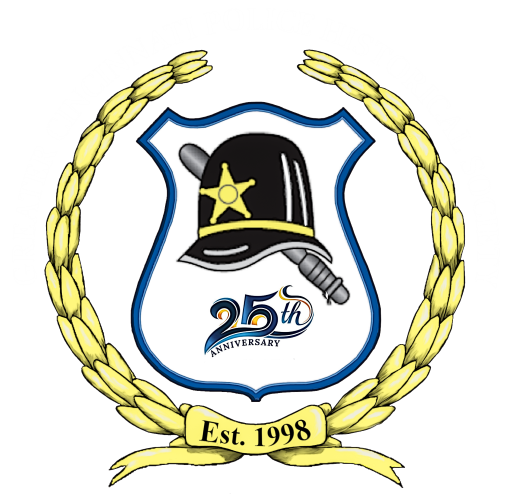
Age: 61
Served: 33 years
1881 to February 27, 1916
OFFICER
John was born about 1855 in Ohio. His father, Bernard Schnucks, during 1868, worked or owned a saloon on the southwest corner at 2nd and Race Street. At the age of 16, John worked as a chair maker. By 19, he was a bar keeper. At 26 he was making chairs again and living at 16 Abigail.
During the latter part of 1881, John joined the Cincinnati Police Department, apparently hired as a Detective by Police Chief Jacob Gessert. Chief Gessert lasted about a month as Chief, but Detective Schnucks lasted decades.
By 1885, he was living in a rooming house at 394 Vine Street. On April 14, 1885, he married Julia Brinkman.
On March 31, 1886 the City of Cincinnati dismissed the entire 400-man Police Department. Beginning the next day, April 1, 1886, under the auspices of the non-partisan Public Safety Commission, a new 300-man Police Department was built. On January 18, 1887, John was rehired as a Patrolman. On March 22, 1887 he was nominated, then promoted back to Detective.
For 31 years, Detective Schnucks had been a Detective and, though it was once mentioned in an article that he did not brag about his arrests, his arrests were captured in newspapers dozens of times each year.
Then, on March 14, 1912, Safety Director Cash eliminated the Detective rank, essentially demoting all the Detectives to Patrolmen, leaving only Chief of Detectives Cal Crim in place. He then named 29 Acting Detectives, only four of which included former Detectives; John Pflug, Frank Hueftlein, Louis Bell, and Joseph Schaefer. Patrolman Schnucks was transferred to the Tenth District in Cumminsville.
By December 1914, a City Councilman started a movement to have Patrolman Schnucks reinstated as a Detective. Apparently, the initiative failed.
On February 25, 1915 he did investigate one last mystery when he happened to be assigned to the beat where B&O Detective Elijah Boileau, Jr. was killed.
INCIDENT
On February 27, 1916 a call was received at the Tenth District Substation in College Hill at 7 o’clock from Hamilton Avenue requesting police response for an Ohio Military Institute student flourishing a pair of pistols. Patrolman Schnucks was detailed to handle it. He rushed to the nearest corner to board a streetcar as it pulled away and ran after it – but missed it.
He was breathing heavily when he went back into Schneider’s Drug Store at Hamilton and Marlowe to catch the next car.
DEATH
He died of a myocardial insufficiency within five minutes. Coroner’s Constable Charles Stagnaro sent the body to the officer’s home at 830 Poplar Street.
He was survived by his wife of thirty years, Mary Julie (Brinkman) Schnucks (58), and daughter, Julie M. Schnucks (30). His funeral service was held on March 1, 1916 at the chapel at Vine Street Cemetery and presided over by Reverend Theodore Moellering of the German Lutheran Trinity church. Many people attended. Pallbearers including Police Lieutenants John Krebs and Jacob Conway and Sergeants Harry Bruggeman were pall bearers. Company G of the Police Department and the Color Guard in the charge of Inspector Michael Kane and Lieutenants James Slattery and Albert C. Venn, escorted the funeral cortege, let by Schmittie’s Band, from the residence to the cemetery. He is buried in Vine Street hill Cemetery.
EPILOGUE
His wife joined him 6 months later on August 22, 1916 and is buried in Grave 9.
His daughter married less than a year after his death during January and she and her husband, Karl Martinek, currently have descendants living in Amelia.
 On December 2, 2014, Joyce Meyer, Price Hill Historical Society Researcher notified the Greater Cincinnati Police Museum Director that she had found in her research another Cincinnati officer, Patrolman Schnucks, who had died in the line of duty. The Museum conducted its extensive research and confirmed the that the officer had indeed died in the line of duty. Then, after several months, the Historian found where he was buried and that he had no headstone.
On December 2, 2014, Joyce Meyer, Price Hill Historical Society Researcher notified the Greater Cincinnati Police Museum Director that she had found in her research another Cincinnati officer, Patrolman Schnucks, who had died in the line of duty. The Museum conducted its extensive research and confirmed the that the officer had indeed died in the line of duty. Then, after several months, the Historian found where he was buried and that he had no headstone.
While conducting his research, he also found that Cincinnati Patrolman Frederick Karsch, another line of duty death, was buried without a memorial about one hundred feet from Patrolman Schnucks.
The Museum worked with the Vine Street Hill Cemetery, Cincinnati Police Department, and Hamilton County Police Association Honor Guard, and Schott Monument to honor each officer by rededicating their graves with the pomp and circumstance due them, and to mark their graves with headstones on November 3, 2015.
Additionally, Vine Street Hill Cemetery who had already erected a memorial to fallen police and fire officers, refurbished that memorial and it too was rededicated.
If you know of any information, archives, artifacts, or images regarding this officer or incident, please contact the Greater Cincinnati Police Museum at Memorial@Police-Museum.org.
© This narrative was revised January 27, 2020 by Cincinnati Police Lieutenant Stephen R. Kramer (Retired), Greater Cincinnati Police Museum Historian, including research information provided by Joyce Meyer, Price Hill Historical Society Researcher, and Cincinnati Homicide Detective Edward W. Zieverink III, Greater Cincinnati Police Museum Curator. All rights are reserved to them and the Greater Cincinnati Police Museum.


